December 16, 2022
Air Date: December 16, 2022
FULL SHOW
SEGMENTS
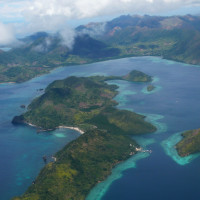
Averting the Biodiversity Crisis
View the page for this story
As many as 1 million species are at risk of going extinct within decades. To try to address this biodiversity crisis, thousands of delegates from around the world are meeting in Montreal, Canada from December 7-19, 2022, with a goal of updating the United Nations treaty on biological diversity. KM Reyes is co-founder and advisor of the Centre for Sustainability PH, in the Philippines. She joins Host Steve Curwood from Montreal to describe the rich biodiversity of the Philippines and the Indigenous Batak people who safeguard it. (12:35)
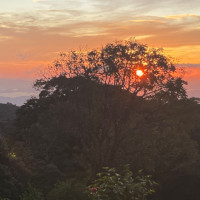
Cloud Forest Bird Count
/ Bobby BascombView the page for this story
Cloud forest ecosystems are becoming warmer and drier with the climate crisis. So, each fall researchers in the cloud forest of Monteverde, Costa Rica conduct a bird census to see what migrant and resident birds are using the forest and how that’s changing with time. Host Bobby Bascomb reports. (10:28)
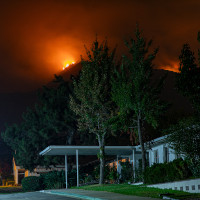
Beyond the Headlines
/ Peter DykstraView the page for this story
In this week’s trip beyond the headlines, Environmental Health News editor Peter Dykstra and Host Steve Curwood unpack the recent Keystone oil spill in Kansas. They then discuss a new study that shows Americans are moving to areas with high wildfire risks. This week’s trip to the past takes them to Holland in 1593 when Cornelis Corneliszoon van Uitgeest received a patent for his wind powered sawmill. (04:32)
I’ll Take Menhaden
/ Mark Seth LenderView the page for this story
Menhaden fish once gathered in schools several miles long and were a common food for predators like sharks, sea birds, and bass. But after humans turned them into everything from supplements to fertilizer their numbers plummeted by roughly 90 percent. In Long Island Sound they’re finally bouncing back and Living on Earth’s Explorer in Residence, Mark Seth Lender, witnesses their return. (02:49)

The Climate Loses at the World Cup
View the page for this story
Despite Qatar’s claim that the 2022 World Cup is carbon neutral, environmentalists are raising concerns about the impact the event is having on both the country and the planet. Although international sports produce far less emissions than top polluting countries, there’s still room for improvement. Brian McCullough, an associate professor at Texas A&M university and co-director of the Sports Ecology Group, joins Host Steve Curwood to explain. (08:53)
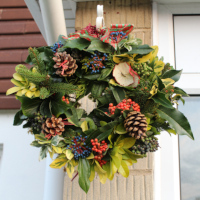
Holiday Decor from Your Own Backyard
View the page for this story
With the winter solstice and holidays upon us, many are choosing to bring the outdoors inside with wreaths, garlands, and Christmas trees. Living on Earth's gardening guru, Michael Weishan, joins Host Bobby Bascomb to share some tips on how to craft some festive holiday decor with natural materials from your own backyard. (07:14)
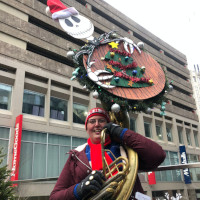
Listening On Earth: Tuba Christmas
/ Sophia PandelidisView the page for this story
The annual “Tuba Christmas” concert, which includes musicians of all ages and skill levels, brings holiday cheer in many places around the world. Living on Earth’s Sophia Pandelidis recorded the Boston festivities. (00:56)
Show Credits and Funders
Show Transcript
221216 Transcript
HOSTS: Bobby Bascomb, Steve Curwood
GUESTS: Brian McCullough, KM Reyes, Michael Weishan
REPORTERS: Bobby Bascomb, Peter Dykstra, Mark Seth Lender
CURWOOD: From PRX – this is Living On Earth.
[THEME]
CURWOOD: I’m Steve Curwood.
BASCOMB: And I’m Bobby Bascomb
COP 15 of the biodiversity treaty meets in Montreal to hash out plans to address the extinction crisis.
REYES: Being at these COPs does give me hope because I see thousands of people descending in one area because we all genuinely care about trying to ensure that our governments are held accountable for making more ambitious targets. So I think it's definitely the community that gives me hope that we will find common ground.
CURWOOD: Also, decorating for the holidays with local plants.
WEISHAN: One of the things I'm always surprised about is the cost of wreaths and decorations at this time of year. You can make some terrific Christmas decorations or holiday decorations that will cost you practically nothing. And it's a very simple process. My advice would start with look in your own backyard.
CURWOOD: That and more this week on Living on Earth – Stick Around!
[NEWSBREAK MUSIC: Boards Of Canada “Zoetrope” from “In A Beautiful Place Out In The Country” (Warp Records 2000)]
[THEME]
Averting the Biodiversity Crisis
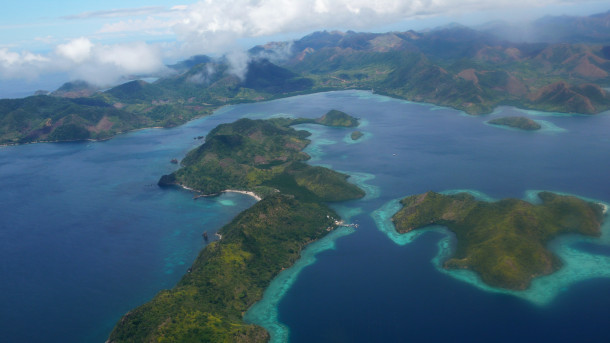
Palawan Island is the largest in the Philippines and is known as “The Last Ecological Frontier of the Philippines." (Photo: Patrick Kranzmüller, Flickr, CC_BY_NC_ND_2.0)
BASCOMB: From PRX and the Jennifer and Ted Stanley studios at the University of Massachusetts Boston, this is Living on Earth. I’m Bobby Bascomb.
CURWOOD: And I’m Steve Curwood.
The biodiversity crisis is often overshadowed by climate change, but just like the climate emergency we ignore it at our own peril. Less diverse ecosystems are less able to absorb excess carbon, respond to extreme storm events, and provide basic ecosystem services like clean water and clean air. According to the United Nations, as many as 1 million species are at risk of going extinct within decades and that’s the fastest rate of extinction in human history. As we go to air, thousands of delegates from around the world are meeting in Montreal, Canada to address the biodiversity crisis by updating the UN treaty. We’ll follow up in the new year with the results of the talks but today I’m joined by KM Reyes, from the Philippines. She’s the Co-Founder & Advisor of the Centre for Sustainability PH and joins me from Montreal where she is attending COP 15 of the Biodiversity Treaty. Welcome to Living on Earth KM!
REYES: Thank you, very happy to be here.
CURWOOD: We're speaking now as the negotiations are proceeding in Montreal and tell me, what's important now for the Philippines in these negotiations? As I understand it, it's one of the most biodiverse places on earth. Describe it for us, please, and tell us in fact, why the Philippines are so graced with so much biological diversity.
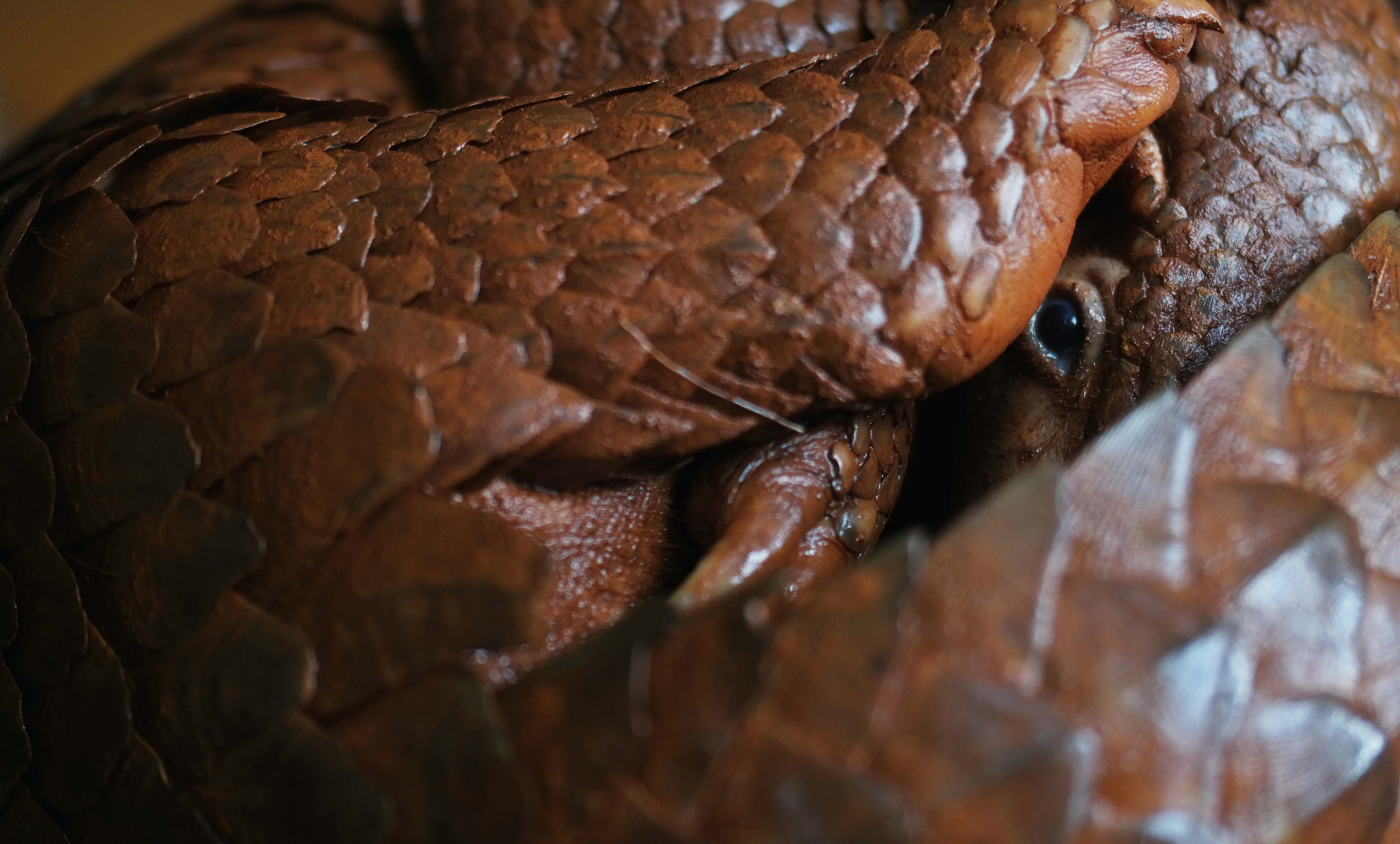
Palawan Pangolin. Pangolins are among the most critically endangered animals due to heavy poaching and worldwide trafficking. (Photo: John Christian Yayen)
REYES: Yeah, so the Philippines is one of only 17 mega-biodiverse countries on the planet. It was previously 95% covered in pristine rainforest, and now only 3% is left.
CURWOOD: Whoa, wait, you've lost all but the last 3%?
REYES: Yes, of pristine rainforest.
CURWOOD: Wow. Okay.
REYES: And even though we only have 3% of pristine rainforest left, we actually still have the most vertebrate diversity on the planet. So we're a really small country, we're made up of 7,000 islands. But we still have incredible biodiversity across our islands, and also in our oceans, so our coral reefs and our seas. We have all sorts of really charismatic wildlife and ocean fauna, from thresher sharks, to the Philippine pangolin, which is critically endangered and the number one poached animal globally. And this area is also this perfect meeting place of volcanoes and the Coral Triangle. So it's a meeting place for all sorts of different, you know, tectonic movements that happened. And that's why we are also really mega biodiverse. And the reason why this specific treaty is so important for us in the Philippines is if we don't have a good global strategy, then we don't have a national strategy to build off. And obviously, as a conservationist, I want the strongest possible policies at the international level, as well as at the national level.
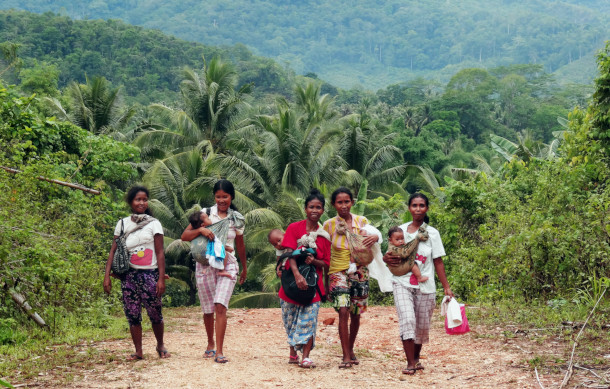
Indigenous Batak mothers of Manggapin. (Photo: Jessa Garibay)
CURWOOD: What are the developing nations and Indigenous peoples asking for at this biodiversity treaty Summit?
REYES: We are lobbying for really ambitious biodiversity targets, including 30 by 30 target, which is a global target to protect 30% of land and ocean by 2030. As well as, and I would argue, most importantly, to ensure that we have the free prior and informed consent of Indigenous peoples and local communities in any kind of protection and conservation that happens. And then the other big piece that we're really fighting for here in Montreal, is that we also have the right finance for it, right. So there are lots of reasons why we have biodiversity loss, you know, whether it's deforestation or other kinds of mining industries, and so on. And these are often activities that are driven by the Global North. And if we're going to reach our biodiversity targets, if we're going to reach these very ambitious goals, we need adequate financing to do it, especially with something like 30 by 30, that requires a lot of follow up monitoring and management of these protected areas.
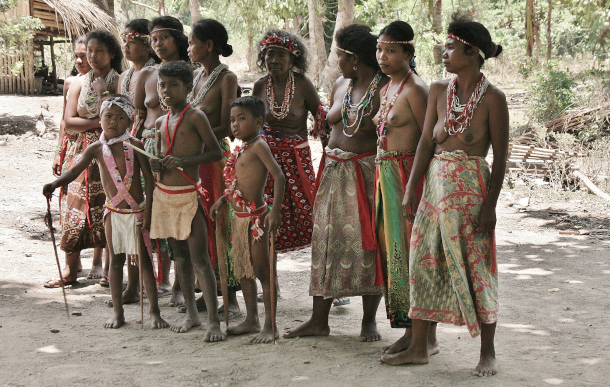
Batak women and children in traditional dress. (Photo: Jessa Garibay-Yayen)
CURWOOD: Tell me a bit more about the role of the Global North here and why financing is necessary to help protect the biological diversity in the Philippines.
REYES: Yeah, so a lot of the environmental destruction is often caused by Global North and industries in the Global North. And so there is a lot of importance here on ensuring that the Global North also pays their dues. For example, you know, we're working on a protected area in Palawan. And we're up against a mining company that is Canadian, funnily enough. And so these are the kinds of international and kind of transnational issues that we deal with when trying to protect biodiversity. And so it's extremely important that the Global North really takes responsibility for the footprint that they're making on biodiversity in different areas, especially in the Global South. And you will see this across mega-biodiverse, you know, Global South countries, the Democratic Republic of Congo is another classic example, whether it's cobalt or nickel, or, you know, other kinds of minerals. And specifically in the Philippines, the big issue that we're dealing with is that we're very rich in nickel. And so this is obviously a key mineral for the electric car revolution. And so for us, in the Philippines, it's very far away in our timeline that we're going to have access to these electric cars, right? A lot of these electric cars will go to Europe and North America, but they're coming from and destroying biodiversity in Global South countries like the Philippines.
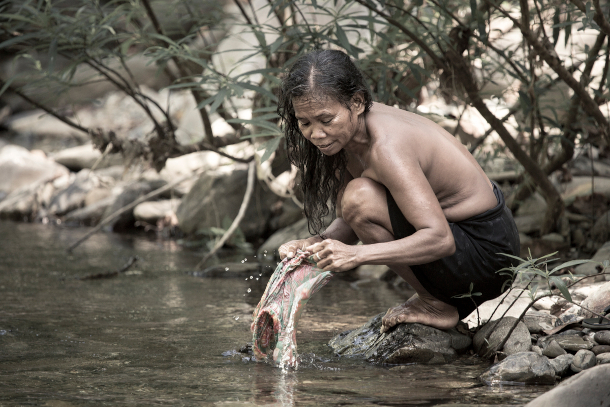
A Batak woman washing clothes in the river. (Photo: Robin Moore)
CURWOOD: Now, what about the Indigenous communities living within the islands there, what's their role in protecting biological diversity?
REYES: So Indigenous peoples globally represent 5% of total population, and protect 80% of global biodiversity. So Indigenous peoples and local communities play an outsized role in ensuring that biodiversity continues. And actually the reason why we still have biodiversity now is because of our Indigenous peoples and local communities that are living in and around our frontlines and protecting these areas, whether it's freshwater and salmon runs, to pristine rainforest. Certainly in the area that we protected, at Cleopatra's Needle Critical Habitat, this is home to the disappearing Batak tribe, there's only 200 people left of this ethnic group, and they have protected this area since time immemorial. So wherever we are in the world, Indigenous peoples and local communities are the key to ensuring that these areas are protected and biodiversity is retained.
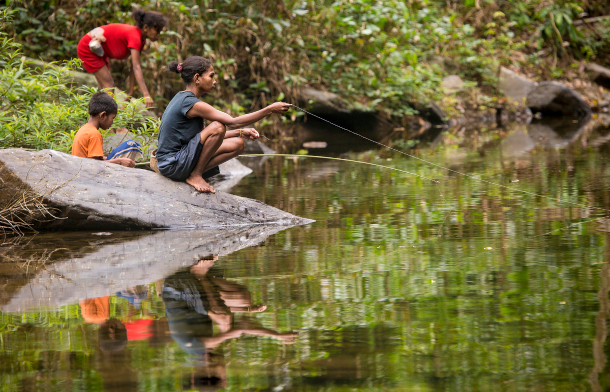
A Batak woman and children fish in the river. (Photo: Robin Moore)
CURWOOD: Yeah, tell me more about Cleopatra's Needle. Your organization, the Center for Sustainability PH worked on helping to protect this area. Why is it so important?
REYES: Cleopatra's Needle Critical Habitat is the Philippines' biggest critical habitat. It's the size of the City of Montreal, so some 41,350 hectares, and it's the highest peak of our city, Puerto Princesa city. It's about 1500 metres above sea level, it takes about four days to hike up to the peak because it's extremely difficult terrain to get up. And it's pristine rainforest, as I mentioned, that is the ancestral home of the Indigenous Batak tribe. And with summary scientific research, we've already been able to identify that it's home to 61 Palawan endemic species and 31 globally threatened IUCN species. So it's an area of extremely important biological diversity. And it's also very important as a critical habitat, because this is habitat that's critical for the survival of a very, very special and threatened species globally, not just in the Philippines. So, this area is magical. It's, you know, flowing rivers and pristine rainforest, the hiking is incredible. It's an area that has many, many sacred spots, and is tied with the culture and tradition of the Indigenous Batak community. And I think without their stewardship, we would not have Cleopatra's Needle, for sure. And also, without this forest remaining, the Batak people would also not survive, they are so tied with this forest that for them, their existence could not be without it. And so for example, you know, their naming of how they name their children is always about, what are the natural things that are around them at the time of birth. So sometimes they're named after the tree that they're born under, or the weather on the day of their birth. It's very much tied in with specifically this rainforest.
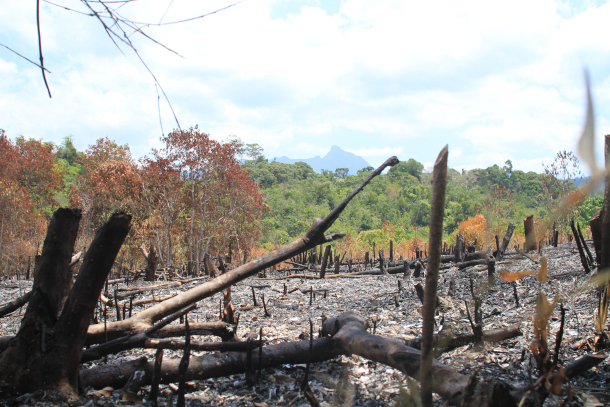
Burned rainforest near Cleopatra’s Needle in the Philippines. (Photo: Jessa Garibay-Yayen)
CURWOOD: By the way, why is it called Cleopatra's Needle? That doesn't sound like an Indigenous term to me anyway!
REYES: Yeah, so Cleopatra's Needle is a military name that came from the US, because it was the US military that mapped most of our island, but it does actually have an Indigenous name. So Cleopatra's Needle is named after the obelisk peak of the mountain, but Puyos ni Bayi is the Indigenous name. And this means the hair bun of Bayi. So Bayi is a common foremother of the Indigenous Batak people, so generations before she was seen as the foremother of their people. And puyos means hair bun. So they see it as the hair bun at the top. And that's what makes it so pointy. And so they see Bayi as the protector of this forest. So internally, we talk about it as Puyos ni Bayi, but internationally, it's called Cleopatra's Needle.
CURWOOD: So, from your perspective as a conservationist, what would be an ideal agreement that will be reached at this biodiversity summit now? What sort of financial commitments and agreements need to happen in order to consider this, I think it's COP 15, or the biological diversity treaty, in order to consider that successful?

KM Reyes is a conservation lobbyist, community organizer, and National Geographic Explorer, based on Palawan Island, the Philippines. She’s the Co-Founder & Advisor of the environmental non-government organization, Centre for Sustainability PH, which she co-founded together with a small group of local colleagues. Their mission is to conserve the Philippines’ last remaining 3% of pristine rainforest through the legal establishment of protected areas. (Photo: Courtesy of KM Reyes)
REYES: For this COP to be successful, we need an ambitious framework that's agreed upon, that has 30 by 30, so protecting 30% of global lands and water; doing it specifically with the free and prior informed consent of Indigenous peoples, and/or recognizing Indigenous territories as part of the 30 by 30 target. We know that Indigenous peoples have protected biodiversity successfully, even if they're not protected areas. And having sufficient financing. So our ask is $70 billion annually from Global North countries to Global South countries in order to finance and upkeep biodiversity protection over the next 10 years. And so $70 billion is a tiny amount of money to be asking for protecting global biodiversity per year, if you compare that to other kinds of spending that, you know, governments are doing, if you think about, you know, how much the US has spent on Ukraine, or how much, you know, the US spends on military every year, $70 billion is not a huge ask to ensure that we have strong and resilient areas for agriculture and ecosystem services like clean running water, like clean air. This is a really small amount of money.
CURWOOD: KM Reyes is the co founder and advisor of the environmental NGO, Center for Sustainability PH. Thanks so much for taking the time with us today.
REYES: Thank you so much.
Related links:
- Centre for Sustainability PH Instagram
- Learn more about Centre for Sustainability
- Centre for SUSTAINABILITY video
- Learn more about KM Reyes
[MUSIC: Rob Harris, “More Lemon Juice” Single, Harritoons]
BASCOMB: Coming up – From the Philippines we’ll travel to another biodiversity hotspot, Monteverde, Costa Rica. Keep listening to Living on Earth.
ANNOUNCER: Support for Living on Earth comes from Sailors for the Sea and Oceana. Helping boaters race clean, sail green and protect the seas they love. More information @sailorsforthesea.org. Support also comes from Friends of Smeagull the Seagull and Smeagull’s Guide to Wildlife. It’s all about the wildlife right next door to you! That’s Smeagull, S - M - E - A - G - U - L - L, SmeagullGuide.org.
[CUTAWAY MUSIC: Rob Harris, “More Lemon Juice” Single, Harritoons]
Cloud Forest Bird Count
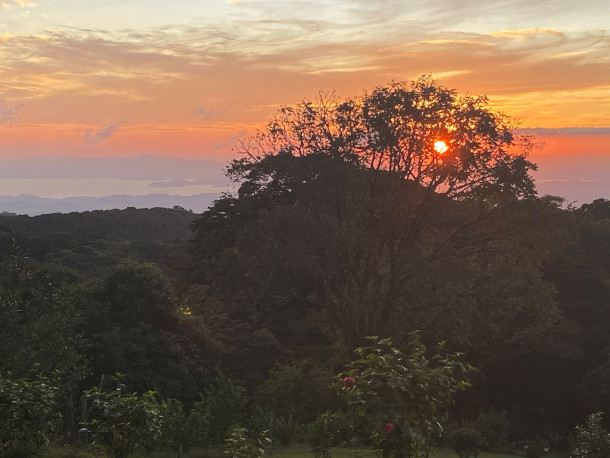
Costa Rica’s cloud forest is home to a large variety of birds – both migrant and resident. (Photo: Bobby Bascomb)
CURWOOD: It’s Living on Earth, I’m Steve Curwood
BASCOMB: And I’m Bobby Bascomb
So, Steve, I know you are a bit of a birder, right?
CURWOOD: Yeah, I often say I’m a recovering birder after all those early weekend mornings of being dragged outdoors by my mom as a kid but full confession I have pair of good binoculars now. And my Merlin app from Cornell is fully updated. It can id birds by sound.
BASCOMB: Ahh, I need to get that. Well, this time of year the birding in the North gets a lot simpler as migratory birds have flown south by now.
CURWOOD: Yes, but I still love to look for the tit mice, the cardinals and the bald eagles.
BASCOMB: You are looking for cardinals in the North but I’m in Costa Rica and keeping an eye out for birds coming down here. I think for a lot of us when certain birds leave the North they’re sort of out of sight out of mind but I’m seeing many species who had to fly thousands of miles to get to the warmer weather here.
CURWOOD: Oh, yeah, it’s just amazing what big distances tiny birds can fly.
BASCOMB: So, I’m here at one stop on the migration path for some birds, the cloud forest in Monteverde, Costa Rica.
CURWOOD: Cloud forests Bobby?
BASCOMB: Yeah, cloud forests are strictly found in tropical mountains where the conditions are just right to deliver a lot of rain and fog for much of the year and they’re among the most biodiverse ecosystems in the world. The forest in Monteverde is a mecca for migratory birds including hummingbirds which come in a dazzling array of colors as their names indicate. There’s the coppery headed emerald, magenta throated woodstar, and the green breasted mango. And flying so far to escape the cold and find food is an amazing endeavor for a bird no longer than your index finger and about the weight of a coin.
CURWOOD: Wow, that is so incredible.
BASCOMB: Yeah, and so each fall researchers in Monteverde check up on these birds. They use fine mist nets to catch some of them as they fly through the forest, including those tiny hummingbirds. So, one morning I tagged along to see what they’re learning.
[WALKING SOUNDS]
BASCOMB: It’s a chilly overcast morning with a fine misty rain hanging in the air. Ficus vines, covered in moss, twist together to form massive trees that dot the wide path I walk through in the forest. In the middle of the trail I soon see several researchers sit around a red plastic table topped with all the tools they will need for a day of field work. They’ve been at it since dawn. By the time I arrive around 8:00 they are collecting information on an unhappy white throated thrush. A medium sized dark gray bird with a white belly.
[BIRD SQUAWK]
BASCOMB: Diego Rodriguez is a local guide and biologist in training, he in intensely focused on his work as he holds the bird and examines it to determine age.
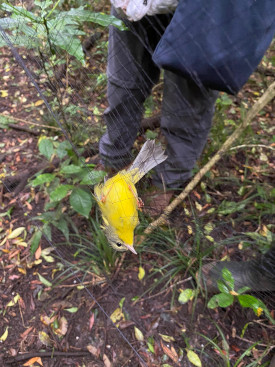
A golden crowned warbler is gently caught in the mist net. (Photo: Bobby Bascomb)
DIEGO: I think it's an adult. But I will check it out.
BASCOMB: Diego firmly holds the body of the bird in the palm of his hand and gently blows a patch of feathers backwards to get a look at the molt limit of the bird.
[BLOWING SOUNDS]
BASCOMB: That’s the spot between a set of feathers grown in different years.
[BLOWING SOUNDS]
LUISA: They change the feathers once a year in the tropics and sometimes you can tell the difference between the feathers from last year to the new year and that is called the molt limit.
BASCOMB: Luisa Moreno is the research coordinator with the Monteverde Institute and Diego’s mentor for this work.
LUISA: When you have a bird born this year they have a different pattern in the feathers like dots or buffy tips or something like that. And then you can tell the difference if that bird was born this year or it’s a second year or a third year. Depending on the species also.
BASCOMB: Diego collects data on gender, weight, and length and Luisa writes it down on a spreadsheet held fast on a clip board. They do this data collection twice a year, now when migrating birds have arrived and again in March before they head north.
[BIRD SQUAWK]
BASCOMB: They look at the overall health and condition of the birds. The absence of feathers on the chest and belly is called a brood patch and would suggests that birds are breeding here.
DIEGO: That looks like a very healthy bird, full grown. Zero zero zero, dos.
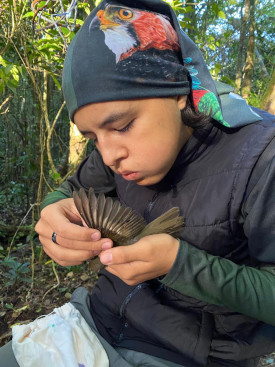
Diego Rodriguez blows on the bird’s feathers to look for the molt limit. (Photo: Bobby Bascomb)
BASCOMB: Diego places a small metal band on the bird’s leg and tells Luisa the number on the tag to write down. He then takes a last look at the bird and opens his palm to release it. It bites the skin between his thumb and index finger then takes off into the woods.
[beating wings and distant squawk]
BASCOMB: that couldn't have felt too good. It looked like a very sharp beak biting your hand.
DIEGO: That's not a very sharp one.
BASCOMB: No?
DIEGO: There are ones that have a sharper one. Yeah.
BASCOMB: We are at about 4500 feet of elevation, a key transitional area before the trees further up the mountain get smaller and become even more covered in moss and other epiphytic plants. Below us the forest is much warmer and drier. Luisa says they want to learn what migratory and resident species are using this forest.
LOUISA: Another thing we want to see if we if we capture a new species, because with climate change, species are moving higher. And we have found like three or four, like you can tell that they are changing in the past 20 years.
BASCOMB: So you're seeing birds here now that you didn't used to see, because of climate change, you think?
LOUISA: Yeah, like the white breasted wood wren, it's one species that you usually in the past, you can’t find here, and now you can find it.
BASCOMB: In the coming decades cloud forests are expected to become warmer and drier with climate change. That will dramatically change this ecosystem and the birds that can make their home here.
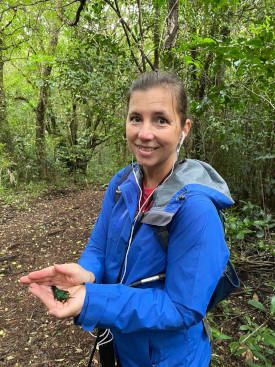
Living on Earth’s Bobby Bascomb warms the purple throated mountain gem hummingbird before release. (Photo: Bobby Bascomb)
LOUISA: We need to understand what is happening and how birds are dealing, any animal in general are dealing with that, and even the plants. I think one way what we can fight climate change is restoring some critical areas.
BASCOMB: As the climate is warming bird species that prefer cool weather are moving higher up the mountain, putting them in competition with birds that usually live here and are stressed with the warming as well.
LUISA: And the species here are not doing that well, that they used to.
BASCOMB: Those birds can move, of course, but they can only go so high up in search of cooler weather before they run out of mountain, forcing them to expend energy looking for another more suitable habitat on another mountain top.
[BIRD SOUND]
BASCOMB: Two other researchers emerge from the woods down the trail a bit and wave for Diego for him to join them.
Do they have a bird down there?
DIEGO: Maybe
BASCOMB: Can we go look?
DIEGO: Let’s see, maybe they have a bird yeah.
[SFX WALKING SOUNDS]
BASCOMB: We walk down the muddy path a bit and turn into the woods at the edge of the mist net they’ve set up. That’s a fine mesh black net strung between two poles about 40 feet apart. It stretches from knee high to about 9 feet up. Birds flying in the understory of the forest can get caught in the net.
[BLACK AND WHITE WARBLER]
BASCOMB: They’ve caught 2 golden crown warblers and a black and white warbler which Diego holds in one hand while trying to untangle the net from the bird’s tiny delicate feet with his other.
DIEGO: This is like the most risk point for birds in the nest because if they get tangled up. You really need to practice this because otherwise you can really hurt the bird.
BASCOMB: How often do they get injured in the process?
DIEGO: If you do a good job it should never happen. This one is almost out.
BASCOMB: Once freed from the net Diego places the bird in a small cotton bag with a draw string top to keep it safe and warm.
[SFX WALKING SOUNDS]
BASCOMB: Back at their red plastic table in the woods Diego uses a clothes pin to hang the bag on a line strung between two trees. 5 other birds in bags, collected by other members of the team, hang alongside it. Diego takes the first bag in the line and pulls out the tiniest bird so far.
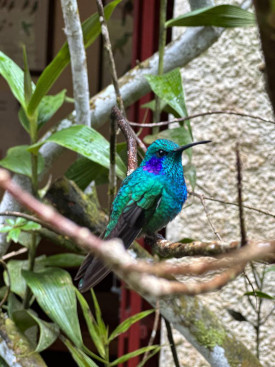
A green violetear hummingbird perches on a nearby tree branch. (Photo: Bobby Bascomb)
BASCOMB: Is this a hummingbird?
DIEGO: Yup.
BASCOMB: What kind?
DIEGO: This one, it’s a purple throated mountain gem, a female.
BASCOMB: Diego collects most of his data and then puts the bird in a small cylinder on a digital scale to weigh it.
DIEGO: cuatro punto cuatro
BASCOMB: It’s 4.4 grams that’s .15 ounces less than the weight of a nickel. Hummingbirds are too small for leg bands so Diego snips a bit of the tail feather. That way if they catch this bird again he won’t record the same information twice. Then the tiny bird is ready to go. Diego opens his hand but it doesn’t move. He passes it to Luisa who cups here hands together and holds the tiny bird to help warm it.
LUISA: The weather is too cold now and also because it was in the net. So they waste a lot of energy fighting there.
LOUISA: Want to hold it?
BASCOMB: Yeah, is that ok? Oh!
LUISA: You can feel the heartbeat.
BASCOMB: Yeah, you can feel it vibrating. That’s the heart beat?
LUISA: No, just because it’s cold.
BASCOMB: While I do my best to warm the bird, Louisa speaks softly and offers it some food.
LUISA: This is sugar and water. The same thing that you have in the feeders. Just to get some energy.
BASCOMB: Is it drinking?
LUISA: No.
BASCOMB: I pass the tiny unmoving bird to another researcher. He must have warmer hands than mine because in less than a minute the hummingbird takes off in a flurry of iridescent wings.
[HUMMING BIRD]
BASCOMB: Satisfied, Luisa turns to the next bird.
Along with the purple throated mountain gem Luisa and her team catch and release 37 birds of 16 different species today, information will be added to the data set researchers have been collecting here since 2014.
LUISA: I love to do this! I love to be in the forest, I really enjoy showing people how to do this, why this is important so yeah I really look forward to do this every year.
BASCOMB: Luisa and Diego, get to hold hummingbirds and occasionally get bitten and they’re also making key contributions to how the cloud forest is changing with the climate crisis.
[BIRD SOUNDS]
Related link:
Learn more about the Monteverde Institute
[MUSIC: Roberto Santamaria, The Latin Allstars, Michael Philip Mossman, “Uchi-Beng-Guau-Guau” on Fiasta al Jazz, TERMIDOR MUSIC]
Beyond the Headlines
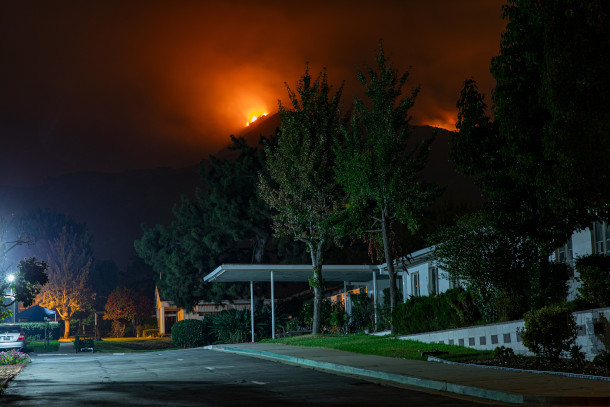
The 2020 Bobcat Fire as seen from Monrovia, California. A study published in Frontiers in Human Dynamics found Americans are moving to areas with high wildfire risk. (Photo: Nikolay Maslov on Unsplash)
CURWOOD: On the line now from Atlanta, Georgia is Peter Dykstra. He's an editor with Environmental Health News. That's ehn.org and dailyclimate.org. Hi there, Peter, how you doing? All set for the holidays?
DYKSTRA: I'm getting set for the holidays and the holidays will be past us soon enough. There's a little unwanted gift in the state of Kansas: there was an oil spill in Mill Creek, which is a tributary that eventually runs to the Missouri River. That spill comes from the Keystone pipeline, the main part of it, which runs from Canada's tar sands fields down to refineries along the Gulf Coast in Texas and Louisiana. That spill is believed by some to already be the biggest land based spill that we've had in years. Keystone, of course, was in the news a few years ago when an addition, a shortcut, called Keystone XL was eventually shot down by the Obama administration after years of protests from farmers, environmentalists, Native American communities throughout the path of Keystone XL. That main pipeline is still running, but in this case, it's still leaking.
CURWOOD: Yeah, and the stuff that leaks, which is called diluted bitumen is some of the most difficult petroleum things to ever get into a pollution situation.
DYKSTRA: It's hard stuff to clean up. It's easy for that dilbit as they call it, to pollute and to keep areas polluted for a long time. The warnings have come out for years. And those warnings, unfortunately, like so many things, are now in the I told you so phase.
“As far as permitting reform, I think the continued spills on this pipeline illustrate the risks pipelines pose, especially when there are construction and pipe integrity issues,” @BillCaram said.https://t.co/ynKV2U4w5w
— Pipeline Safety Trust (@pstrust) December 14, 2022
CURWOOD: That's right. Hey, what else do you have for us today?
DYKSTRA: There's a report out that has been published in the journal Frontiers in Human Dynamics, talking about the incongruity of Americans moving into danger zones, zones that are suffering more and more due to climate change from wildfires and extreme heat. And so you're seeing cities, and particularly urban areas, in some of the worst places to put a city to begin with, like Los Angeles, and when those areas expand, the suburbs and the exurbs, the potential for wildfires expands as well.
CURWOOD: That's right. The so called wildland-urban interface doesn't seem to matter to developers who are putting up these houses, huh?
DYKSTRA: No, and there's a lot playing into that in a very negative and dangerous way. As these cities grow, real estate prices go up. What happens when real estate prices go higher is that the suburbs tend to sprawl. We're taking forested land and turning it into cultivated suburban land that has so many more fire risks to it that we're going to see increased risks in a lot of different ways.
CURWOOD: In forested areas, wildfires are relatively infrequent in a natural state. It might only be once in 100 years. But of course, no one has been around for the last 100 years to warn people, if you build there, the fire is going to come through.
DYKSTRA: If you build it, those wildfires will come. And the other aspect of this that's very concerning, is not just in western cities where water is very scarce, but even in places like here in the Atlanta area, as you build out and population increases, you're putting more and more stress on the ability of water to be provided everywhere for agriculture as well as drinking water for humans.
CURWOOD: Okay, time now for us to take a look back at the annals of history with you.
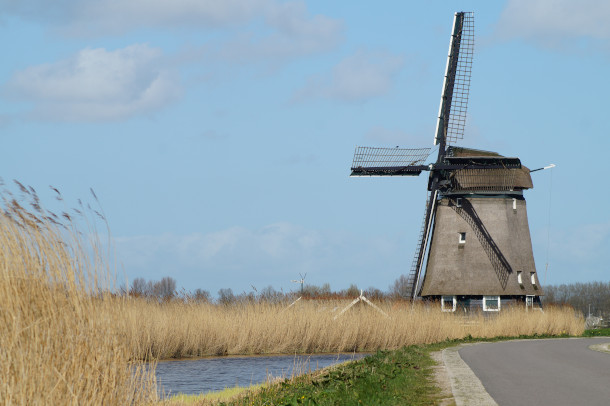
A windmill in Holland. On December 15th, 1593, Cornelis Corneliszoon received a patent for his wind powered sawmill. (Photo: Niels and Marco on Unsplash)
DYKSTRA: December 15th, 1593. There's a man named Cornelis Corneliszoon–that's the closest Dutch pronunciation I can give–received a patent from the state of Holland for a windmill operated sawmill. And so back in the 16th century, you had one of the first steps toward using windmills for industrial purposes.
CURWOOD: Well thanks, Peter. Peter Dykstra is an editor with Environmental Health News, that's ehn.org and dailyclimate.org. And we will talk to you again real soon. Happy holidays!
DYKSTRA: Happy holidays, Steve. Talk to you soon.
CURWOOD: And there's more on these stories Living on Earth webpage. That's loe.org.
Related links:
- NPR | “Kansas Oil Spill Is Keystone Pipeline’s Biggest Ever, According to Federal Data”
- Read the study on human migration and wildfire risk here
- Click here to watch a wind powered sawmill in action
[MUSIC: Jimi Hendrix, “The Wind Cries Mary” on Are You Experienced, Experience Hendrix L.L.C, Sony Music Entertainment]
I’ll Take Menhaden
Young menhaden, or herring, gather in the water of Long Island Sound. (Photo: © Mark Seth Lender)
BASCOMB: Menhaden fish once gathered in schools several miles long and were a common food for predators like sharks, sea birds, and bass. But after humans turned them into everything from supplements to fertilizer their numbers plummeted by roughly 90 percent. Living on Earth’s Explorer in Residence, Mark Seth Lender, has more.
I’ll Take Menhaden
Stuart B. McKinney National Wildlife Refuge
Long Island Sound
© 2022 Mark Seth Lender
All Rights Reserved
LENDER: The tide comes in from the narrows of the Race. Like Vincent van Gogh swirling paint. And on the tide herring! In sheaves and shoals. Some keep to the meander of the shoreline. Others follow the flow, it creeps and curls. Most of them hold, floating over the deepest part in the glimmer and the gloam of the surface, and the just below. Here and there and there. You could walk the water on their backs as thick as salt drying in the flats. Wide mouths that scoop and sieve the smallest things; they themselves can guess but cannot see the numbers they consume nor the numbers that they be.
Algonquin named them a singular and special name: Menhaden (Makes Things Grow!)
A herring gull glides above the herring (Photo: © Mark Seth Lender)
Ring-bill, black-back, laughing gull, herring gull all unaware menhaden have gathered. They count in their full feathered generations since as it was now. The umbra that forms beneath them speeding in line with the path of their flight - is unremarked. They make no interpretation. No living gull has seen it! The meaning lost to the memory of their kind that these are fishes of their birth right. While menhaden know in their bones: A Crossbow of Shadow means Seabird Coursing the Sea. You must Flee! You must flee!
Menhaden then leaping, dart-shaped and speeding a Marking a Making a Message in the Clear.
We are here.
Once again.
We are here.
A herring gull with his prize. (Photo: © Mark Seth Lender)
Now Herring Gull flies low. As they should! Wings in the shape of that bow, nocking an Arrow of Fishes. Straight-to-the-point Herring Gull glides, and dips his head towards the prize and takes his winnings in menhaden. It took time. The knowledge lost to find. To repair, the damage done the Web of Life and set things right.
BASCOMB: That’s Living on Earth’s Explorer in Residence, Mark Seth Lender.
Related links:
- Read the Field Note for this essay
- Author and photographer Mark Seth Lender’s website
- Special thanks to Stewart B. McKinney National Wildlife Refuge
[MUSIC: Karen Lovely, “Fish Outta Water” on Fish Outta Water, Independent]
CURWOOD: Coming up – Greening the World Cup soccer tournament. That’s just ahead on Living on Earth.
ANNOUNCER: Funding for Living on Earth comes from you, our listeners, and United Technologies, combining passion for science with engineering to create solutions designed for sustainability in aerospace, building industries, and food refrigeration.
[CUTAWAY MUSIC: Owen Rochester Jazz, “Deck The Halls” on Jingle Bells, Owen Rochester Jazz]
The Climate Loses at the World Cup

A close-up of the FIFA World Cup trophy. UC Boulder’s Roger Pielke estimates global sport’s environmental impact is roughly equivalent to 6 minutes of China’s annual carbon emissions. (Photo: Rhett Lewis on Unsplash)
BASCOMB: It’s Living on Earth, I’m Bobby Bascomb
CURWOOD: And I’m Steve Curwood
This year’s World Cup in Qatar has been a thrilling ride both on and off the pitch. The soccer competition has been surrounded by controversies, including FIFA’s choice of Qatar as the host which employed modern slavery to build cities and stadia for the matches. This year’s global soccer event has also been criticized for its toll on the environment including the carbon emissions for travel and the tremendous amount of energy used to cool outdoor venues in 120 degree heat. Despite protests, FIFA and Qatar are claiming this World Cup is carbon neutral. Brian McCullough is an associate professor at Texas A&M University and co-director of the Sport Ecology Group. He says the carbon emissions numbers from the Qatar games suggest this might be the most carbon intensive World Cup ever held.
MCCULLOUGH: Well, you know, as there's been a lot of reports coming out that are highly critical of the environmental impact, saying that it's never been higher. Right now, it is quite concerning, again, with the numbers being so much higher than in previous years, including the Russian World Cup and whatnot before. Something I just read this morning was, you know, equating the carbon footprint, about 51% of that carbon footprint was coming from fan travel. The construction of facilities is also a major contributing factor to the overall footprint of the games. In some regards, you can see other contexts that Qatar is obviously a very wealthy nation from its oil exports, and its natural resources there of again, predominantly oil. And so you know, the country requires a lot of importing of different raw materials for construction. And then, of course, being in a relatively remote area of the world, transportation is going to be quite exorbitant. And we see that again, with that 51% of the overall carbon footprint of the event or the estimates for the event itself.
CURWOOD: Brian, compare for me, the carbon emissions from international sporting events, like the World Cup, compare those to emissions from other sectors, or even entire nations.
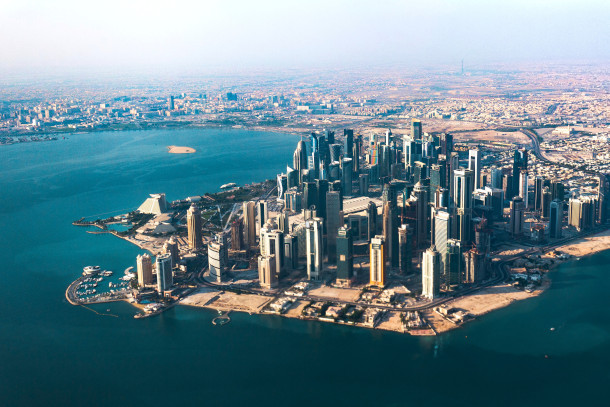
An aerial shot of the city of Doha in Qatar, where 6 of the 8 stadiums used in the World Cup are located. Qatar has come under scrutiny for using carbon offsets to claim the event is carbon neutral. (Photo: Radoslaw Prekurat on Unsplash)
MCCULLOUGH: There's a great researcher at University of Colorado in Boulder, Roger Pielke, he delivered a speech at an academic conference in Europe this past summer, and put that global sport environmental impact into context where he was saying that the calculations that have been used in popular press and amongst different people in the space, that that would equate to about six minutes of China's annual carbon emissions. Now, granted China's largest carbon emitting country in the world, but still kind of puts that into perspective of where sport lies. And granted, sport needs to clean up its act, especially mega events like this, we need to be more conscious of the environmental impacts and reduce that as best and as most as we can. But I think the challenge I think with specifically with this World Cup, is that they're claiming carbon neutrality through offsetting programs. And there's some criticisms about the carbon offsetting programs that they chose. And then there's other aspects to about, you know, can you really claim carbon neutrality, when you're maybe over reliant on carbon offsets themselves.
CURWOOD: Doesn't sound like you're very confident of their statement that they will be carbon neutral using carbon offsets.
MCCULLOUGH: Right. And, you know, there's different guidelines on greenhouse gas emissions and striving for being carbon neutral. And there's these guidelines would point to that you really cannot rely on carbon offsets to achieve carbon neutrality. And so I think it would be far fetched for any event to claim that they are carbon neutral, especially when you consider how some of these carbon offset programs work, that, in essence, it takes several years to gather the carbon out of the atmosphere, through whether it's tree planting or whatnot. But in essence, if it takes 5, 10, 15, 30 years to draw that carbon out of the atmosphere, you know, 30 years down the road, you're saying, Oh, now we've offset what our impact was 31 years ago for this specific event. So I'm always wary when someone or an event makes that claim. And there's even been some recommendations by consultants within this, well-known consultants in the space, to avoid making such claims as that because there's not even an agreed upon methodology on how to calculate it. And so that could be almost comparing apples to oranges across events with regards to the environmental impact assessments.

Fans cheer on the Republic of Korea soccer team during the Korea vs. Uruguay match while watching from Seoul. Fans can reduce their climate impact by being mindful of what they buy and how they get around in the cities they visit, McCullough says. (Photo: Courtesy of Jeon Han, Korean Culture and Information Service, Flickr, CC BY-SA 2.0)
CURWOOD: Now, the World Cup as well as other sporting competitions, is really huge, right? People come from all over the world. And that travel seems to, as you say, be the bulk of the carbon emissions, or certainly a plurality of the carbon emissions involved. So for fans of these types of sporting events, what can they do to reduce their own environmental impact?
MCCULLOUGH: We've been able to participate in a couple of research studies, and one being the USA Special Olympic Games in Seattle, and what the event planners there did was make sure that they were designing and choosing facilities that were on public transportation routes, and that greatly reduced the environmental impact. And they designed campaigns to educate people that were coming to Seattle, perhaps for the first time and educating them again, how accessible the venues were, the hotels were still on the transportation lines. So there's a lot of planning that can go into this context. Now, that's a much smaller of event, but still had 10s of 1,000s of people attending that, both for volunteers, participants, and spectators. Ultimately, you can kind of create those campaigns, and you have to educate fans. Because if I'm traveling somewhere that I might not know, I'm not really sure if I need to rent a car or not, especially if it's maybe here in the United States, whereas Europe has better public transportation or, you know, not knowing Doha, how well I can get around. But ultimately, what fans can do is try to educate themselves and see what options there are when they're going to a mega sporting event, whether it's, you know, let's say you're flying out to Arizona this year for the Super Bowl. It's, you know, understanding "How can I get from the airport in Phoenix to my hotel, and then from my hotel to the venue itself, using either mass transit or reduced emissions transportation," because that's going to be the biggest thing. The other thing also too, is just, you know, looking to see, minimize your consumption. You know, it's trying to go about and being wise with our spending, because that spending also has, you know, environmental impact, whether it's buying apparel, whether it's at home, or it's on site. But also, you know, looking at all the things that we're buying from food and you know, our rental car, or whatever it might be. So it's just trying to reduce those aspects as best as we possibly can. And I mean, in a lot of ways traveled frugally, but also that frugality will help reduce your environmental impact as well.
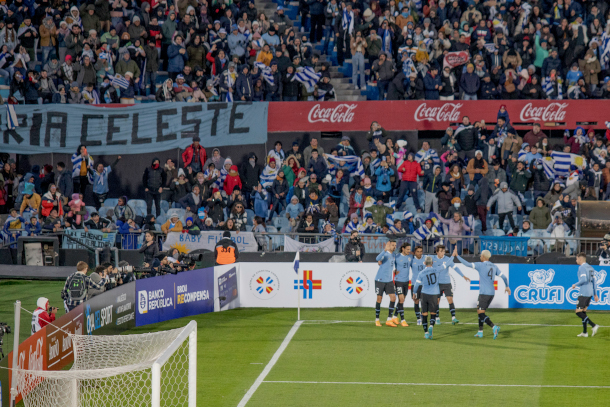
The Uruguay National Football Team celebrates during their match against Panama. It is estimated that just over half of the 2022 World Cup’s carbon footprint comes from fan travel. (Photo: Jimmy Baikovicius, Flickr, CC BY-SA 2.0)
CURWOOD: Be stingy for the environment?
MCCULLOUGH: Oh, maybe that's my mentality too much.
CURWOOD: Now, the next World Cup will be jointly hosted by the United States, Canada and Mexico. So what lessons from Qatar's World Cup can the North American hosts learn to reduce the environmental impact of this mega event?
MCCULLOUGH: Yeah, and there's different circles that argue that because the locations are so much further apart, those individual cities can absorb the environmental impact better than having it concentrated in one specific region like this World Cup. But ultimately, the lessons that are going to be learned, hopefully, will be around scheduling. But the context are so different, again, specifically, because the locations are so much further apart. But also, you know, kind of, contrary to the one thinking that if we have it more spread out, it'll be able to absorb this impact more, there's also kind of circles that are debating whether or not there will be increased travel between cities as people come to North America and travel between different sites to watch many games because a lot of people have complimented in a positive way that all the games are right there so that they've been able to see more matches and seeing different groups play than if they were in a format that we're going to be seeing in 2026 and Canada, United States and Mexico.
CURWOOD: Brian McCulloch is an associate professor at Texas A&M University and co-director of the sport ecology group. Thanks so much for taking the time with us today.
MCCULLOUGH: Thank you.
Related links:
- Read more about the Sports Ecology Group’s work here
- Grist | “Lessons from the World Cup: How A Changing Climate Is Changing Sports”
- Le Monde | “World Cup 2022: The ‘Mirage’ Of Carbon Offsetting”
- BBC | “What Would a Green World Cup Look Like?”
[MUSIC: The White Stripes, “Seven Nation Army” on Elephant, Third Man Records, Sony Music Entertainment]
Holiday Decor from Your Own Backyard
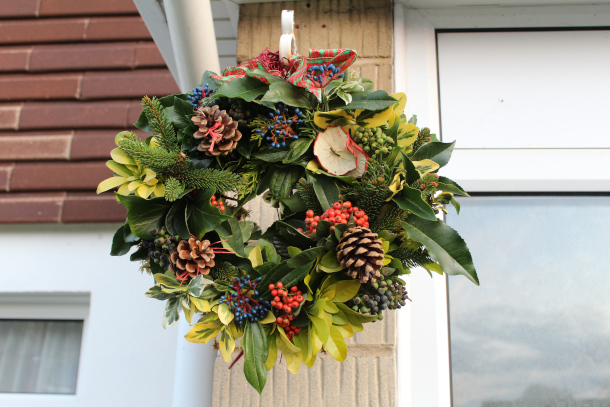
Michael Weishan’s tips for creating a winter wreath start with looking for evergreen branches in your own backyard. (Photo: Joybot, Flickr, CC BY-SA 2.0)
BASCOMB: Well the winter solstice and holiday season are just around the corner now. It’s a time when many of us choose to bring the outside in with a Christmas tree, wreaths, and garland. Those icons of the holiday season can be expensive or if you wait too long, unavailable. But Living on Earth’s gardening guru, Michael Weishan has some alternatives to suggest, and he joins me now. Michael, welcome back to Living on Earth!
WEISHAN: I'm delighted to be back.
BASCOMB: So winter is just about here, the solstice is coming up on the 21st. And households across the country are sprucing up their decor for the new season, for the holidays. What advice do you have for people who maybe want to make decorations with some plants they could find?
WEISHAN: Well, my advice would start with looking your own backyard. One of the things I'm always surprised about is the cost of wreaths and decorations at this time of year, especially here in New England, we had this terrible drought. And so a lot of the Christmas trees and all of the stuff from Canada became very, very costly. So if you have plants growing in your backyard that are evergreen, and I don't just mean pines and balsams, I'm talking about plants like in the South like magnolia, or in the West Coast, bay leaves or rosemary. You can make some terrific Christmas decorations or holiday decorations that will cost you practically nothing. And it's a very simple process.
BASCOMB: So what is the process? How do you go about doing that with things from pine to rosemary, which sounds amazing, by the way. Rosemary, such a beautiful smell.
WEISHAN: Oh, yeah, yeah, I mean, so what you need is a ring, essentially, and you can buy them at any craft store, or you can buy them online. And it's essentially just a series of interlocked wire rings that you build a wreath on. Or you can buy shapes for pendants or in other words, you need some sort of wire support, which you can purchase. And then you essentially just go out and cut a lot of stuff. And it's surprising how much material you actually need for a wreath, which tells you something about why they're so expensive. You can consult many videos on YouTube about exactly how to go about the process. But essentially, you cut material that is going to be of interesting color and contrast. For instance, here I would probably pick yew, dark english yew, and boxwood, and pine, some pine. Southward, I would pick magnolia, along with it's blossoms. And of course box all the way through the south. Anything evergreen. Bay. Laurel is another fantastic leaf texture to use in these wreaths. And you essentially assemble your ingredients in big piles. And then you take some florist's wire and you wire up little brackets of different combinations. Of, say spruce, with some berries or with different leaves and foliage. One of the most beautiful wreaths I saw a number of years ago was actually made from boules of cotton. Granted, I don't have any cotton fields behind me. But for those folks who do, that type of material works really well. And essentially, you use the wire and create these little brackets, tie the stems together, and then you just simply tie the brackets, one on top of the other, around the wreath. It sounds complicated, it's not. You'd be surprised at how simple it really is. And fun. This is a great thing to do with kids, because once you've done the pruning and stuff, you just have piles of greens, right and you can assign them to help make all these little brackets and let them use their imagination and put together colors and combinations and things that you like. And then once you have the base form, you can decorate it with anything. I use all sorts of berries. Our native deciduous hollies, for instance, the ones without the evergreen leaves, have fantastic berries at this time of year. Often crabapples will have wonderful berries. Mahonia, all sorts of shrubs, you know, you name it wherever you are in the world of the United States or beyond, you will have plants that have beautiful berries at this time of year. And you can include them in the wreath and and do this for pennies, literally, compared to $60, $70, $80 for some of these wreaths. Big savings and fun to do.

Evergreen shrubs like boxwood can be trimmed and formed into a tabletop Christmas tree. (Photo: Teleflora Flowers, Flickr, CC BY-NC-ND 2.0)
BASCOMB: Yeah, that's a huge savings. Now what about, you know, people that maybe have waited a little too long to get their Christmas tree and find they're all sold out? I mean, sure, you know, you can go and cut down your own if you live in a place where that's possible. But any alternative suggestions or thoughts for those last minute folks that might be listening to us?
WEISHAN: Well, you know, it's funny, I was just at a large department store chain today and they were selling these little tabletop Christmas trees, the sorts of things you've seen in a Charlie Brown Christmas, you know. And they were $25, $30. And essentially, they're tops of trees, right, you know, they just chop the tree off. I'm thinking, you know, why don't you make these out of boxwood? And I used to do this for many, many years. I may or may not have time to do it this year, but you can just use some equivalent of floral foam, hopefully an ecological version thereof, to mound essentially a large triangle for any size that you want. It can be a foot tall, two feet tall, three feet tall, obviously can't get too big because it'll topple over. Then I just use skewers, bamboo skewers to hold these pieces together and then you put the individual cut pieces of boxwood in them to form a tree of boxwood. And it makes a beautiful tabletop type of Christmas tree that can then be decorated with lights. A friend of mine used to decorate it with long stem roses and other flowers as a centerpiece for the table. It's really lovely and it's very, very easy to do and then just keep it watered over the holiday season and it'll last often way past New Year's.
BASCOMB: Hm. And for people not in New England, you could do the same thing as you were suggesting earlier with rosemary or magnolia or any you know any evergreen that's growing in your region.
WEISHAN: Well remember box is only minimally hardy here in Boston. So all the folks all the way down to almost the panhandle can grow boxwood. And you can also buy, it's very expensive to buy, but you could buy it through florists if you're apartment bound, say in New York City. But again, yes, you could potentially use almost any leaved evergreen. I mean, you could use branches of pine in the far north, you could use anything and create your entire shaped tree. And the nice thing is, your tree, if you do it, right, doesn't have any holes. You know, you can make it as full or as not full as you want. And it's perfect on all sides too, so you can see it from 360. But you're right, absolutely, any type of... I think bay might be kind of fun. I'm a big fan of bay and laurel.
BASCOMB: And you know, I always think it's really fun too to, you know, slice oranges and dry them out to put on a wreath or, you know, make decorations. Any other thoughts along those lines?
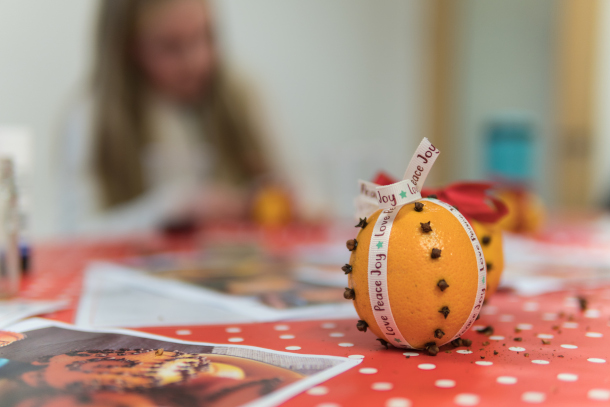
Pomanders are a simple craft that leave a warm, aromatic scent throughout the whole room. (Photo: Lee Simpson, Flickr, CC BY-NC-ND 2.0)
WEISHAN: There was this really great project I used to do with my mom at this time of year, which is a strange thing called a pomander. Not something that you hear much anymore, but was essentially just an orange that we then very carefully inserted whole cloves into and then tied it up with a string. It took a long time. I mean, and your fingers got pinched by you know, pushing those bloody cloves into the thing. But by the time you were done, you had this incredible scented pomander that you would hang up in your closet. And it was fantastic because as the orange slowly dried, the scent was revealed. And they would last oh I don't know a good year or so and then it would be time to make them again. Get out the oranges and get out the cloves.
BASCOMB: I love that idea. I'll have to try that with my kids. Michael Weishan is our very own gardening guru and former host of the Victory Garden on PBS. Michael, thank you so much for all of these great ideas today.
WEISHAN: Oh, my pleasure. And happy holidays.
BASCOMB: Oh, same to you. Happy holidays.
Related link:
Learn more about Michael Weishan
Listening On Earth: Tuba Christmas
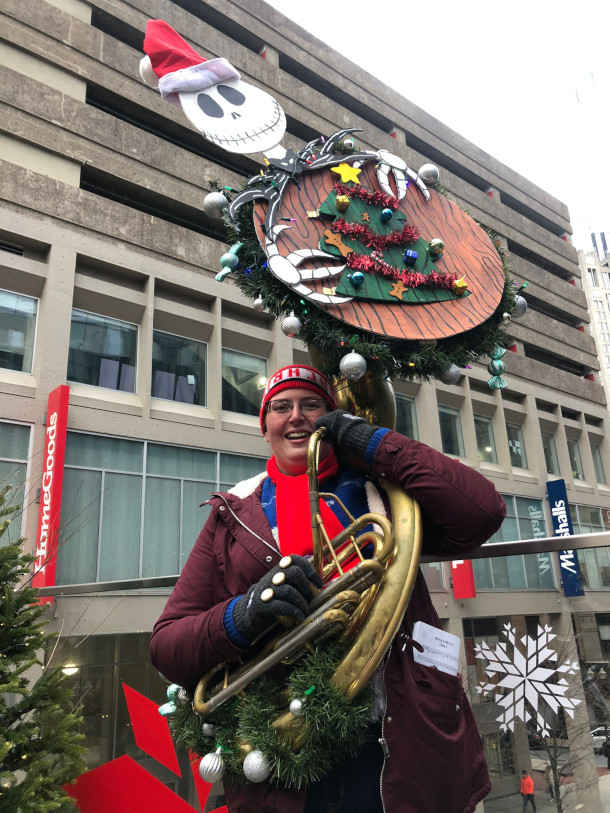
According to an enthusiastic crowd, Gabby Grondalski had the most festively decorated tuba at this year’s Tuba Christmas. (Photo: Sophia Pandelidis)
[TUBA MUSIC]
CURWOOD: Roughly a hundred tuba players of all ages recently braved the cold to ring in the holiday season in the Downtown Crossing neighborhood of Boston.
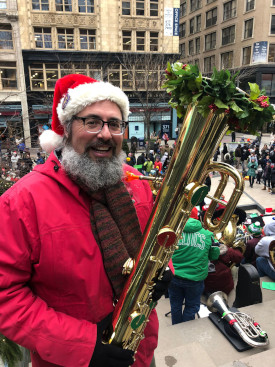
Mike Zucca was one of the hundred or so tuba players who participated in the free public concert. (Photo: Sophia Pandelidis)
[TUBA MUSIC]
CURWOOD: “Tubachristmas” is an annual, international, tradition.
Musicians of any skill level can participate in many places around the world.
[TUBA MUSIC]
CURWOOD: Living on Earth’s Sophia Pandelidis recorded the Boston festivities.
[TUBA MUSIC]
Related links:
- Tuba Christmas | “What is Tuba Christmas?”
- The Boston Calendar | “Snowflake Crossing: A Winter Wonderland in Downtown Crossing”
[MUSIC: Atlantic Five Jazz Band, “We Wish You A Merry Christmas” on Bar Music Moods (Christmas Edition Vol.2), Peppertoire Recordings (LC 15763)]
CURWOOD: Living on Earth is produced by the World Media Foundation. Our crew includes Fern Alling, Naomi Arenberg, Paloma Beltran, Chloe Chen, Iris Chen, Josh Croom, Jenni Doering, Mark Kausch, Kharishar Kahfi, Mark Seth Lender, Don Lyman, Louis Mallison, Aynsley O’Neill, Sophia Pandelidis, Jake Rego, Ashley Soebroto, and Jolanda Omari.
BASCOMB: Tom Tiger engineered our show. Alison Lirish Dean composed our themes. You can hear us anytime at L-O-E dot org, Apple Podcasts and Google Podcasts, and like us, please, on our Facebook page - Living on Earth. We tweet from @livingonearth. And find us on Instagram at livingonearthradio. I’m Bobby Bascomb.
CURWOOD: And I’m Steve Curwood. Thanks for listening!
ANNOUNCER: Funding for Living on Earth comes from you, our listeners, and from the University of Massachusetts, Boston, in association with its School for the Environment, developing the next generation of environmental leaders. And from the Grantham Foundation for the protection of the environment, supporting strategic communications and collaboration in solving the world’s most pressing environmental problems.
ANNOUNCER 2: PRX.
Living on Earth wants to hear from you!
Living on Earth
62 Calef Highway, Suite 212
Lee, NH 03861
Telephone: 617-287-4121
E-mail: comments@loe.org
Newsletter [Click here]
Donate to Living on Earth!
Living on Earth is an independent media program and relies entirely on contributions from listeners and institutions supporting public service. Please donate now to preserve an independent environmental voice.
NewsletterLiving on Earth offers a weekly delivery of the show's rundown to your mailbox. Sign up for our newsletter today!
 Sailors For The Sea: Be the change you want to sea.
Sailors For The Sea: Be the change you want to sea.
 The Grantham Foundation for the Protection of the Environment: Committed to protecting and improving the health of the global environment.
The Grantham Foundation for the Protection of the Environment: Committed to protecting and improving the health of the global environment.
 Contribute to Living on Earth and receive, as our gift to you, an archival print of one of Mark Seth Lender's extraordinary wildlife photographs. Follow the link to see Mark's current collection of photographs.
Contribute to Living on Earth and receive, as our gift to you, an archival print of one of Mark Seth Lender's extraordinary wildlife photographs. Follow the link to see Mark's current collection of photographs.
 Buy a signed copy of Mark Seth Lender's book Smeagull the Seagull & support Living on Earth
Buy a signed copy of Mark Seth Lender's book Smeagull the Seagull & support Living on Earth

